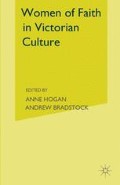Abstract
Charlotte Brontë’s Jane Eyre is the best-known anti-heroine of the Victorian missionary movement. Yet her refusal to marry the zealous St John Rivers and to be his fellow-missionary to India stems not from any serious questioning of missionary aims and methods, but rather from a deep unease about the demands placed upon women by patriarchal Christianity in one of its most imperious nineteenth-century manifestations.1 For the cold, stern and self-possessed Rivers, modelled it is said upon the real-life missionary hero to India Henry Martyn, Jane has all the feminine qualities required of the exemplary Christian helpmeet. As he tells her, he has studied her character carefully and found her to be ‘docile, diligent, disinterested, faithful, constant, and courageous; very gentle and very heroic’.2 Above all, she is endowed in abundance with that most prized of female Christian virtues: self-sacrifice. In his plans for Jane’s future this capacity for self-immolation is to be tested to the full, as he urges her to simplify her ‘complicated interests, feelings, thoughts, wishes, aims’ and to pursue only one goal: that of fulfilling ‘the mission of your great Master’.3 The ambivalence of just who is the master whom Jane is called upon to obey is evident from River’s androcentric identification of his own ambitions for the future with the will of God himself, and it was a feature of many Victorian Christian appeals to women.
Access this chapter
Tax calculation will be finalised at checkout
Purchases are for personal use only
Preview
Unable to display preview. Download preview PDF.
Notes
This is not to imply that Charlotte Brontë herself had no such doubts. As Tom Winifrith has shown, Helen Burns’ rejection of the doctrine of eternal damnation in the novel, which was a fundamental tenet of nearly all Victorian missionaries, was shared by her creator. See T. Winifrith, The Brontës and their Background (London: Macmillan, 1973), p. 52.
J. Jack and M. Smith, eds, Jane Eyre (Oxford: Clarendon Press, 1969) p. 515.
C. Yonge, Womankind, 2nd edn (London: Walter Smith & Innes, 1889), p. 2.
Quoted in R.J. Dunn, ed., Jane Eyre: Authoritative Text Background Criticisms, 2nd edn (New York: W.W. Norton & Co., 1987), p. 442.
E.C. Dawson, Heroines of Missionary Adventure (London: Seeley & Co., 1909).
In formulating this approach I have drawn upon M.J. Corbett, Representing Femininity: Middle-Class Subjectivity in Victorian and Edwardian Autobiographies (Oxford: Oxford University Press, 1992).
In 1909 out of a total staff of 1390 overseas workers in the CMS, 438 were single women. For a discussion of the significance of the rise in the numbers of single women missionaries, see S. Gill, Women and the Church of England From the Eighteenth Century to the Present (London: SPCK, 1994), pp. 173–81.
The same point has been made with regard to Canadian women missionaries in R.R. Gagan, A Sensitive Independence: Canadian Methodist Missionaries in Canada and the Orient, 1881–1925 (Montreal: McGill-Queen’s University Press, 1992).
A.B. Webb, Sisterhood Life and Woman’s Work in the Mission Field of the Church (London: Skeffington & Sons, 1883), p. 10.
Mrs Ashley Carus-Wilson, Irene Petrie, Missionary to Kashmir (London: Hodder & Stoughton, 1900), pp. 49–50.
W.P. Livingstone, Christina Forsyth of Fingoland: The Story of the Loneliest Woman in Africa (London: Hodder & Stoughton, 1918), p. 13.
C.W. Mackintosh, Coillard of the Zambesi. The Lives of Franyois and Christina Coillard of the Paris Missionary Society in South and Central Africa, 2nd edn (London: T. Fisher Unwin, 1907), pp. 96–7.
A. Giberne, A Lady of England: The Life and Letters of Charlotte Maria Tucker (London: Hodder & Stoughton, 1895), pp. 83
This theme is explored in J. Rowbotham, Good Girls Make Good Wives: Guidance for Girls in Victorian Fiction (Oxford: Basil Blackwell, 1989).
A. Hodges, ed., Love’s Victory: Memoirs of Fanny Woodman (London: Marshall Brothers, 1899), pp. 13–14.
F. Coillard, On the Threshold of Central Africa. A Record of Twenty Years Pioneering among the Barotsi of the Upper Zambesi (London: Hodder & Stoughton, 1897), p. 433.
J. Telford, Women in the Mission Field: Glimpses of Christian Women among the Heathen (London: Charles H. Kelly, 1895) p. 192.
Baroness Burdett-Coutts, ed., Woman’s Mission. A Series of Congress Papers on the Philanthropic Work of Women by Eminent Writers (London: Sampson Low, Marston & Co., 1893), p. 360.
There is a growing literature on the impact of women missionaries on non-western societies. This includes F. Bowie, D. Kirkwood and S. Ardener, eds, Women and Missions: Past and Present (Oxford: Berg, 1993)
N. Chaudhuri and M. Strobel, eds, Western Women and Imperialism: Complicity and Resistance (Bloomington: Indiana University Press, 1992)
M. Bird, Persian Women and their Creed (London: Church Missionary Society, 1899), p. 25.
M.C. Gollock, River, Sand and Sun being Sketches of the CMS Egypt Mission (London: CMS, 1906), pp. 50–75.
R. Fisher, Twilight Tales of the Black Buganda, 2nd edn (London: Frank Cass, 1970), p. 198.
R. Fisher, On the Borders of Pigmy Land (London: Marshall Brothers, 1905), p. 82.
Editor information
Editors and Affiliations
Copyright information
© 1998 Palgrave Macmillan, a division of Macmillan Publishers Limited
About this chapter
Cite this chapter
Gill, S. (1998). Heroines of Missionary Adventure: The Portrayal of Victorian Women Missionaries in Popular Fiction and Biography. In: Hogan, A., Bradstock, A. (eds) Women of Faith in Victorian Culture. Palgrave Macmillan, London. https://doi.org/10.1007/978-1-349-26749-1_13
Download citation
DOI: https://doi.org/10.1007/978-1-349-26749-1_13
Publisher Name: Palgrave Macmillan, London
Print ISBN: 978-1-349-26751-4
Online ISBN: 978-1-349-26749-1
eBook Packages: Palgrave Literature & Performing Arts CollectionLiterature, Cultural and Media Studies (R0)

